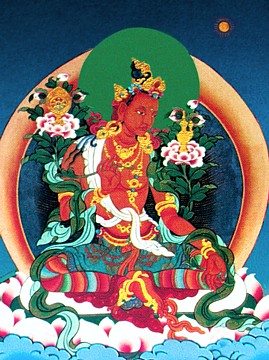Distinguishing the Middle from Extremes

Distinguishing the Middle from Extremes (Skt. Madhyāntavibhāga; Tib. དབུ་མཐའ་རྣམ་འབྱེད་, üta namjé, Wyl. dbus mtha' rnam 'byed; Trad. Chin. 辨中邊論頌) — one of the five treatises of Maitreya. It is included among the so-called "Thirteen great texts", which form the core of the curriculum in most shedras and on which Khenpo Shenga provided commentaries. He states in his Prologue to Abhisamayalankara Commentary that this text was "composed for those to be trained through the teachings of the Mahayana Mind Only system of philosophy".[1]
In [this text], Maitreya describes the multifaceted, interdependent processes whereby consciousness manifests and expresses itself. He also points to the actual, intrinsic nature of these processes—a nature that, devoid of both object and subject, neither exists as process nor as consciousness. The path, he explains, is unified knowledge and compassion. Experience with this seamlessness allows us to see beyond the blinding extremes of conceptual constructs. When, on this path of experience, we equally acknowledge the expressions of mind and their intrinsic nature we will, he promises, discover a flawless and bountiful perspective—a discovery of unlimited resources.[2]
Outline
The text has five chapters:
| This section contains Tibetan script. Without proper Tibetan rendering support configured, you may see other symbols instead of Tibetan script. |
- Characteristics (Tib. མཚན་ཉིད་, mtshan nyid)
- Obscurations (Tib. སྒྲིབ་པ་, sgrib pa)
- Reality (Tib. དེ་ཁོ་ན་, de kho na)
- Cultivating antidotes (Tib. གཉེན་པོ་བསྒོམ་པ་, gnyen po bsgom pa)
- The unsurpassed vehicle (Tib. ཐེག་པ་བླ་ན་མེད་པ་, theg pa bla na med pa)
Text
The text survived in Sanskrit in the form of a manuscript discovered in Tibet by Rahul Sankrityayan. Also the commentary by Vasubandhu and the sub-commentary by Sthiramati have been found in Sanskrit. It has been translated into Tibetan (D 4021), Chinese, Korean and English.
- The Stanzas on Distinguishing the Middle from Extremes (Skt. Madhyānta-vibhāga-kārikāḥ; Tib. དབུས་དང་མཐའ་རྣམ་པར་འབྱེད་པའི་ཚིག་ལེའུར་བྱས་པ་, Wyl. dbus dang mtha' rnam par 'byed pa'i tshig le'ur byas pa; Trad. Chin. 辨中邊論頌, Sim. Chin. 辨中边论颂). Tibetan text:
 དབུ་དང་མཐའ་རྣམ་པར་འབྱེད་པ་ (Derge Pedurma). Sanskrit text at Digital Sanskrit Buddhist Canon: Madhyāntavibhāga kārikā
དབུ་དང་མཐའ་རྣམ་པར་འབྱེད་པ་ (Derge Pedurma). Sanskrit text at Digital Sanskrit Buddhist Canon: Madhyāntavibhāga kārikā
Quotations
ཉན་དང་ཀློག་དང་ལེན་པ་དང༌། །
འཆད་དང་ཁ་དོན་བྱེད་པ་དང༌། །
དེ་སེམས་པ་དང་བསྒོམ་པའོ། །
སྤྱོད་པ་དེ་བཅུའི་བདག་ཉིད་ནི། །
Copying texts, making offerings, charity,
Study, reading, memorizing,
Explaining, reciting aloud,
Contemplating and meditating—
These ten activities
Bring merit beyond measure.
- Maitreya, Distinguishing the Middle from Extremes, chapter 5, verse 9
Commentaries
Indian
- Vasubandhu, Commentary on Distinguishing the Middle from Extremes (Skt. madhyānta-vibhāga-bhāṣya; Tib. དབུས་དང་མཐའ་རྣམ་པར་འབྱེད་པའི་འགྲེལ་པ་, Wyl. dbus dang mtha' rnam par 'byed pa'i 'grel pa). Tibetan text:
 དབུས་དང་མཐའ་རྣམ་པར་འབྱེད་པའི་འགྲེལ་པ་ (Derge Pedurma)
དབུས་དང་མཐའ་རྣམ་པར་འབྱེད་པའི་འགྲེལ་པ་ (Derge Pedurma)
- English translation: Commentary on the Separation of the Middle from Extremes, in Stefan Anacker, Seven Works of Vasubandhu: The Buddhist Psychological Doctor, Motilal Banarsidass, 2nd Edition, 2002, ISBN 978-8120802032.
- English translation: Commentary on Distinguishing the Middle from the Extremes, in Maitreya's Distinguishing the Middle from the Extremes (Madhyāntavibhāga): Along with Vasubandhu's Commentary (Madhyāntavibhāga-Bhāṣya): A Study and Annotated Translation by D'Amato, Mario. New York, American Institute of Buddhist Studies 2012. ISBN|9781935011057.
- Sthiramati Commentary on Distinguishing the Middle from Extremes (Skt. madhyānta-vibhāga-ṭīkā; Tib. དབུས་དང་མཐའ་རྣམ་པར་འབྱེད་པའི་འགྲེལ་བཤད་, Wyl. dbus dang mtha' rnam par 'byed pa'i 'grel bshad) . Tibetan text:
 དབུས་དང་མཐའ་རྣམ་པར་འབྱེད་པའི་འགྲེལ་བཤད་ (Derge Pedurma)
དབུས་དང་མཐའ་རྣམ་པར་འབྱེད་པའི་འགྲེལ་བཤད་ (Derge Pedurma)
Tibetan
- Khenpo Zhenga, Annotation-commentary on the Stanzas on Distinguishing the Middle from Extremes
- English translation: Annotation-commentary on the Stanzas on Distinguishing the Middle from Extremes, in Middle Beyond Extremes: Maitreya's Madhyantavibhanga with Commentaries by Khenpo Shenga and Ju Mipham, Dharmachakra Translation Committee (Snow Lion, 2007).
- Ju Mipham Rinpoche, Garland of Radiant Light: A Commentary on the Treatise Distinguishing the Middle from Extremes
- English translation: Garland of Radiant Light: A Commentary on the Treatise Distinguishing the Middle from Extremes, in Middle Beyond Extremes: Maitreya's Madhyantavibhanga with Commentaries by Khenpo Shenga and Ju Mipham, Dharmachakra Translation Committee (Snow Lion, 2007).
- Rongtön Sheja Kunrig
- English translation: Adorning Maitreya's Intent: Arriving at the View of Nonduality, translated by Christian Bernert (Snow Lion, 2017).
References
- ↑
 Prologue to Abhisamayalankara Commentary by Khenchen Shenga
Prologue to Abhisamayalankara Commentary by Khenchen Shenga
- ↑ Middle Beyond Extremes: Maitreya's Madhyantavibhanga with Commentaries by Khenpo Shenga and Ju Mipham (Snow Lion, 2007), pages 14-15.
Teachings Given to the Rigpa Sangha
- Khenpo Tashi, Rigpa Germany, 9-27 March 2021
Further Reading
- A Study of the Madhyāntavibhāga-bhāṣya-ṭikā, by Richard Stanley. Doctoral dissertation, Australian National University, April, 1988.
